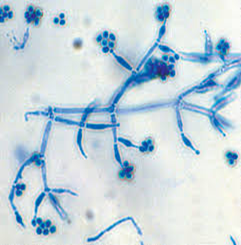Soil pathogens are diverse and adapted to multiple environments. With the evolution of research, it was understood that biological management aimed at controlling soil diseases is based on frequent entries, with the correct microorganisms, focusing on building a balanced management and not the eradication of a species.
Among soil pathogens (Figure 1), some stand out throughout the season, causing damage to grasses and legumes of interest:
In regions with high humidity and temperatures between 10ºC and 21ºC, white mold (Sclerotinia slerotiorum) stands out, attacking more than 400 species with soaked lesions that can lead to the death of seedlings, in addition to forming resistance structures that survive during years in the fields.
In years of high rainfall, initially damping off of seedlings (Rhizoctonia spp. and Phytium spp.) may result in reduced stand and, later in the season, damage to Phomopsis soyae, Fusarium spp. and Phytophthora Soyae can result in significant losses from stem and pod canker, vessel rot and root rot in reeds.
In hot years, with low precipitation and compacted soils, Macrophomina phaseolina stands out, causing lesions in the collar of the plant and contaminating rootlets.
Thinking about grasses, foot sickness (Gaeumannomyces graminis var. graminis) is a fungal disease that develops in temperatures between 12°C and 20°C with poorly drained soils and excessive rainfall, resulting in the death of plants in regrowing beds.
In addition, several pathogens that cause leaf diseases survive in crop residues throughout the season, resulting in the leaf spot complex (Colletotrichum truncatum, Cercospora kikuchii, Spetoria glycines and Corynespora cassicola).

Figure 1 – Main diseases caused by pathogens found in soybean and wheat arable soils.
Although we do not have registered beneficial microorganisms for each of these diseases, we can control them indirectly by biological disease management techniques, using the biological balance of the growing medium (soil) as the main technique of integrated disease management (IDM). Among the beneficial microorganisms available for commercial use today, bacteria of the genus Bacillus and fungi of the genus Trichoderma stand out (Figure 2).
Figure 2 – Microscopy images of Bacillus and Trichoderma. (Image: AgroInovadores).
Fungi of the genus Trichoderma are filamentous fungi, with a high capacity to colonize the rhizosphere of plants, isolated in temperate climates and acidic soils, in some cases capable of producing resistance structures and surviving in extreme situations. Among the species available in commercial products aimed at biocontrol, the following stand out: Trichoderma harzianum, Trichoderma asperellum, Trichoderma afroharzianum.
To feed, fungal hyphae release extracellular enzymes, which degrade organic material. Species highly efficient in biological control actions produce in quantity and quality genes that encode enzymes that break down organic compounds (glucanases, chitinases and proteases). These enzymes, together with secondary metabolites, define the characteristic antibiotic activity of fungi of the genus Thichoderma. In addition, there is competition for space with disease-causing microorganisms, induction of resistance via gene activation, and growth promotion mediated by phytohormones.
Bacillus bacteria, on the other hand, are versatile and found in all regions of the world, being able to colonize the soil, shoots, roots and grains of plants, insects, invasive plants, among other places. Within this versatility, we highlight the control of plant diseases, in shoots and roots, and of pests, especially Coleoptera, Lepidoptera and Diptera. species: Bacillus amyloliquefaciens, Bacillus licheniformis, Bacillus pumilus, Bacillus subtilis and Bacillus velezensis, Bacillus aryabhattai, Bacillus circulans and Bacillus haynesii.
These Bacillus produce enzymes and phenolic compounds that damage harmful microorganisms, antibiotics and antioxidants that act both in plant metabolism and in the metabolism of harmful microorganisms, exopolysaccharides that act as a physical barrier in the roots, in addition to promoting growth and occupying entry sites in the plant that would be used by disease-causing microorganisms. All these processes preferentially take place in the roots, but can occur in shoots and reproductive structures.
Seeking to measure the efficiency of the action of these microorganisms on plant diseases, we have evaluated the efficiency of using a Bacillus-based bioinput in comparison with chemical molecules usually positioned for the management of white mold (Scletorinia sclerotiorum), in order to identify how the use of the biological product in the development of soybean culture behaves in relation to chemicals.
These microorganisms have gained prominence as alternative and sustainable technologies for the management of soil diseases, acting as long-lasting biocontrol agents, promoting the development and health of the plants of interest in the application season and in subsequent seasons, guaranteeing an efficient biological management of the soil. .




